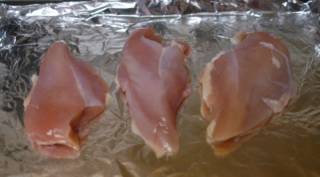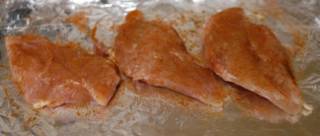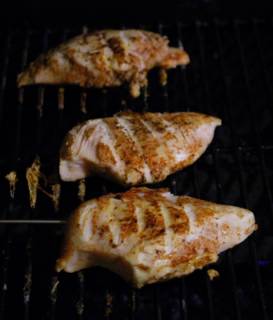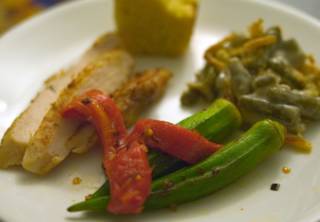 This is the secret: brine the chicken breasts. Take four cups of cold water and add a tablespoon of table salt (add more if using kosher salt - about 1-1/2 to 2 tablespoons). Stir the water to get the salt to dissolve. Once the solution is no longer cloudy and is clear, put the chicken breasts into a large resealable plastic bag and pour the solution into the bag. Seal the bag and refrigerate for at least three hours and no more than six hours (the chicken may become too salty). Rinse the chicken after you remove it from the brine and dry with paper towels.
This is the secret: brine the chicken breasts. Take four cups of cold water and add a tablespoon of table salt (add more if using kosher salt - about 1-1/2 to 2 tablespoons). Stir the water to get the salt to dissolve. Once the solution is no longer cloudy and is clear, put the chicken breasts into a large resealable plastic bag and pour the solution into the bag. Seal the bag and refrigerate for at least three hours and no more than six hours (the chicken may become too salty). Rinse the chicken after you remove it from the brine and dry with paper towels. Now rub 1/2 tsp. ground cayenne pepper, 1 tsp. ground coriander seed, 1/2 tsp. ground cinnamon onto both sides of each breast.
Now rub 1/2 tsp. ground cayenne pepper, 1 tsp. ground coriander seed, 1/2 tsp. ground cinnamon onto both sides of each breast. Place the breasts onto a heated grill for 3 min. on each side. Adjust the grill to low (or move the breasts to the low side of a two level fire) and cook until the internal temperature reaches 160°F (70°C), about ten minutes (on my grill). If you don't have an instant read or meat thermometer, I recommend two alternatives. First, you can poke a hole in the breast (with a knife or fork) and see if the "juices run clear". If the chicken is undercooked, the liquid that comes out will carry a pink or yellow hue. When the chicken is done, the liquid that comes out is clear as water. Alternatively, you can cut into the chicken and look at the color. The breast should be completely white. Another popular method is to press on the chicken and feel if it is done. This is a technique that takes experience and is not recommended for your first time. The chicken will feel springy, but not soft. It should also not be hard (then it's overcooked). The benefit of this technique is that the chicken is not violated with holes or cuts that can release juices that would otherwise keep the breast tender and juicy. I recommend learning the touch technique by pressing on breasts that are done so you can get a feel for how the breast should feel for future meals.
Place the breasts onto a heated grill for 3 min. on each side. Adjust the grill to low (or move the breasts to the low side of a two level fire) and cook until the internal temperature reaches 160°F (70°C), about ten minutes (on my grill). If you don't have an instant read or meat thermometer, I recommend two alternatives. First, you can poke a hole in the breast (with a knife or fork) and see if the "juices run clear". If the chicken is undercooked, the liquid that comes out will carry a pink or yellow hue. When the chicken is done, the liquid that comes out is clear as water. Alternatively, you can cut into the chicken and look at the color. The breast should be completely white. Another popular method is to press on the chicken and feel if it is done. This is a technique that takes experience and is not recommended for your first time. The chicken will feel springy, but not soft. It should also not be hard (then it's overcooked). The benefit of this technique is that the chicken is not violated with holes or cuts that can release juices that would otherwise keep the breast tender and juicy. I recommend learning the touch technique by pressing on breasts that are done so you can get a feel for how the breast should feel for future meals. I served the chicken breast with the Sauteed Okra with Roasted Red Peppers, Green Bean Casserole, and fresh corn bread.
I served the chicken breast with the Sauteed Okra with Roasted Red Peppers, Green Bean Casserole, and fresh corn bread.Grilled Skinless Chicken Breast (serves 6)
| Heat grill (two level fire) | |||||
| 4 cups water | combine | brine 4 hours | |||
| 1 Tbs. table salt | |||||
| 3 boneless, skinless chicken breasts | season | grill on high 2 min. per side | grill on low until 160°F | ||
| 1/2 tsp. ground cayenne pepper | |||||
| 1 tsp. ground coriander seed | |||||
| 1/2 tsp. ground cinnamon | |||||
Related Articles

Normally you are very explicit in your instructions. However, this time you missed even a basic instruction:
What is 'brine' and how do you 'brine' chicken breasts?
Thanks.
brine == salt-water, i.e. kinda like pickling, but not as severe....
it's clearer if you look at the flow-chart...
--S
I'm sorry. I had meant to go back and write that section before publishing the article. Because of my schedule, I write my articles a little at a time (whenever I can grab a few minutes) and don't necessarily write them in any particular order. Usually, I will write a framework or outline of an article and then fill it in as time permits. In this case, I forgot to fill in the details to the brining.
Good catch,
Michael
I'm actually a semi-decent cook (enough that my wife prefers my cooking even though she's better at it) but I haven't 'brined' anything before. Looks like I'll have to experiment soon.
Love the site! Even more, I love baiting the anonymous idiot that leaves trolling comments... but then again, I'm evil (well, not really, usually).
(I like lime with almost everything!)
Before I relocated here, someone in Michigan warned me: 'You better get used to the taste of Old Bay seasoning, they put it on everything'. Truer words have rarely been spoken.
Plump breasts, not chewy, kids both love it.
Mother in law asked for the recipe.
Don't think you could ask for higher praise!!!!
I mean't the chicken breasts. Please excuse me!!!!!!!!!
What is the purpose of the brining--what does it do?
Also, do you have any suggestions for someone who doesn't have a grill?
Thanks,
Alexis
Also, do you have any suggestions for someone who doesn't have a grill?
Brining serves to purposes - 1. to intoduce more liquid into the meat so as it cooks it doesn't completely dry out if you overcook it slightly, 2. intoroduce some flavor into the meat.
I have an article on brining if you want more info.
If you don't have a grill, you can broil the chicken under your oven's broiler, or pan fry it. Cooking times will vary and the final result will be a bit different (especially if the chicken is allowed to sit in it's own juices while cooking.
thanks, love the site :)
I'm trying to picture brining on the molecular level (can't help it, I'm a chemist). Do you think salting the chicken, i.e. without the water, will produce the same effect? I saw Maddhur Jaffrey do this with shrimp whilst rinsing them throughly before cooking. I tried it myself and it transformed the texture of the shrimp. It gave a kind of crispiness or snap if you will that you don't get otherwise.
A good experiment to try: chicken breast in varying amounts of salt and water.
LT
I wrote an article on brining a while ago that might help explain how brining works. Salting a chicken (without water) goes a long way to providing flavor, but you can't do it too long or the outer areas of the meat get too salty while the interior stays about the same (unless you cut it into thin pieces). The texture of the chicken also changes a little. Brining works well for larger chunks of meat because the lower concentration of salt allows the salt to penetrate at a slower rate and results in a more evenly salted interior.
1. Include grams instead of cooking measures... accurate digital scales make this easy.
2. What is the concentration of the brine - in grams per cc?
3. It might be practical to use non contact IR thermometer reading for chicken breast internal temp ... this is somewhat dependent on the emmisitivity of the material being measured, but might be handy - perhaps someone has done the correlation between IR reading and internal temp.
Keep up the good work... a proper recipe and equipment should give good results every time.
1. Include grams instead of cooking measures... accurate digital scales make this easy.
2. What is the concentration of the brine - in grams per cc?
3. It might be practical to use non contact IR thermometer reading for chicken breast internal temp ... this is somewhat dependent on the emmisitivity of the material being measured, but might be handy - perhaps someone has done the correlation between IR reading and internal temp.
Keep up the good work... a proper recipe and equipment should give good results every time.
You cannot use an IR thermometer to get an internal temperature.
You can do that... but why not add some salt to the tandoori marinade? The yogurt base of the marinade should work well with the salt to add flavor into the flesh of the chicken.
For me, it was 10 minutes after the initial six. This is dependant on your grill and your chicken breasts, so please use a thermometer or a knife to cut into the breast to determine if it's done.
Yes. Addition of curd in brine helps a lot in softening chicken. Further, it improves the flavour.
PLONK!
jeesh, I haven't seen one popup, not o-n-e........
yup. keep refrigerated for anything more than 30 minutes or so.
You can definitely thaw the chicken breast in the brine, but the duration of the soak time will have to be adjusted through experimentation.
Yes, but your chicken will be lower in sodium.
I am a bit concerned about dry chicken. Can you brine, then drain and marinate? Or will marinate do the trick. If so, what would you recommend for timing. I planned on marinating the chicken for 24 hrs. prior to grill time.
I have a grilled pepper lime chicken recipe with fresh lime juice/cracked pepper/hot sauce/onion marinate. I have Costco boneless skinless chicken breasts-I would like have some 'on deck' to place in the oven on warm, while I wait to restock chafing dish.
Any advise? Suggestions
Jean[/b]
Kosher chicken is salted already. I don't recommend brining it full strength since it will taste overly salty then. You can try soaking it in plain water or water with a little bit of salt in it to "plump" it up before cooking.
a brine - usually salt & sugar in water - is aimed at making the meat more moist and juicy.
one can add 'stuff' to a brine for flavor.
pushing that, there's a marinade - which is aimed primarily at introducing flavor.
most brines do not include an acid component
many / most marinades do include an acid.
acid may be vinegar, fruit juices, wine, lots of liquids on the acid scale.
so what? valid question.
the process of "cooking" - typically by heat - causes changes to the structure of proteins.
interestingly enough, "acids" produce the same changes.
some tv chef once demonstrated you can "cook" fish at room temperature in a bowl of lemon juice. the acid makes the same protein changes as the heat. if you need a home proof, buy some salmon, cut in half, put one pc in oven, liberally douse other pc with lemon juice, observe results.
so.... vinegar & chicken -
first vinegar has a taste - and that'll show up in the finished product. wine vinegar, cider vinegar, balsamic, etc. all have their own flavor profiles.
second, it will denature aka start to cook the proteins. too much too long can produce a chunk of chicken that is tough/chewy on the outside.
in my experience a splash of vinegar does help with marinade flavor penetration. a really mild acid - such as buttermilk - can go overnight with good results.
however, overdoing the acid is not a good approach.
Thank you!!
Ajay
I use a charcoal Weber. Should I use the direct method? Indirect method? How many briquets shoud I use? And how should I time it?
I use a charcoal Weber. Should I use the direct method? Indirect method? How many briquets shoud I use? And how should I time it?
I would build a two stage fire. Start with a hot fire providing direct heat to sear, then move to a low fire to finish. I don't use briquettes - only hardwood charcoal which seems to vary from manufacturer to manufacturer quite a bit, so I can't really provide guidance on how much to use. Don't time, use a fast response digital meat thermometer and go by internal temperature instead.
Chicken's in the brine right now.
thx
In this particular case, the chicken was cooked over low direct heat with the lid closed.
Sorry, this was one of my more poorly written articles/recipes...
I love brining - it makes the meat so much more juicy and flavorful!
Defrosted 4 breasts.
Put 18g salt in 1 pint water.
Soaked for 2h
Dried off on towel.
Rubbed lightly with spices.
Seared 45sec each side oiled smoking hot cast iron broiling pan.
Finished in halogen oven 200C (400F?) for ~15min removing the thinner breasts earlier.
TASTY, TASTY, TASTY! Maybe a little less salt next time, but overall, WHAT A DIFFERENCE! Not dry in the slightest. An incredible transformation.
You sir are a genius. Cheapest frozen breast I could find, turned out as good as any I've had out. Without skin too. It's a miracle. - Will be replacing the spice rub with some Tikka / Tandoori / Cajun spice, but other than that, and reducing the salt a little. Other than that, simply perfect.
The brining is a great idea just take it easy on the cinnamon B)
Thanks for the amazing website. I've been using it as a guide, as I recently am getting into cooking.
Btw, I used 600ml water, 15g salt for 4 hours. The cayenne overpowered the other flavors, but I like it spicy so that was fine